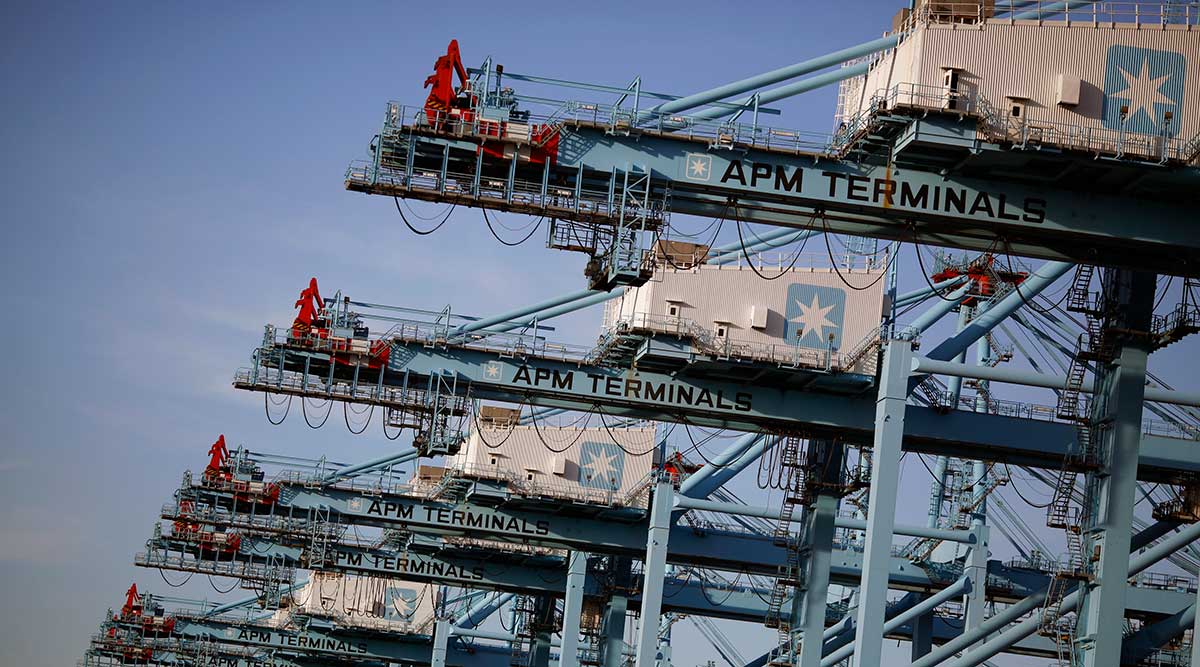Biggest Ship Ever to Call on US East Coast to Visit Port of Virginia

All that talk about big ships coming to the Port of Virginia? It's no joke.
The biggest ship ever to call on entire U.S. East Coast is scheduled to arrive May 8 at Virginia International Gateway in Portsmouth.
The COSCO Development, about 250 feet shy of the length of the Empire State Building laid on its side, can carry 13,092 TEUs or standard 20-foot containers — the half-size boxes often seen on trailers hauled around Hampton Roads.
That's about 3,000 more units than the MOL Benefactor can handle. That ship broke the port's 10,000-TEU barrier just eight months ago.
"This is something that the port has been planning for for a decade," John Milliken, chairman of the Virginia Port Authority's board, said after its meeting March 28.
The convergence of the widening of the Panama Canal and the consolidation of ocean carriers as slowing global trade and overcapacity slashed profits made the arrival of larger ships a foregone conclusion.
"This was going to happen," Milliken said.
As more of the largest ships — those in the 18,000-plus TEU class — move into the Asia-Europe trade lane, still-massive vessels such as the COSCO Development are moving elsewhere, like onto Asia-U.S. East Coast services.
The COSCO Development's first East Coast stop will be Virginia, after a journey that starts in Hong Kong and includes visits to several Chinese ports before heading across the Pacific Ocean and through the Panama Canal.
It's part of a weekly service, meaning that a ship in the same size range will call on the port every week starting in early May.
The ship will bypass the ports of Savannah, Georgia, and Charleston, South Carolina, on its way north, stopping at both after its brief stay in Virginia. This particular service will not call on the Port of New York-New Jersey.
But don't read too much into that. Another COSCO service connecting Asia and the U.S. East Coast that starts next month bypasses Virginia, calling on Savannah, Charleston and New York-New Jersey. None of the vessels on that service, though, can carry more than an estimated 8,500 TEUs.
The Bayonne Bridge connecting Staten Island and New Jersey doesn't have the air draft to let big ships such as COSCO Development pass under it, though that problem is expected to be fixed by the end of the year.
About 4,000 containers will come off or on the ship during its stay in the port. Ordinarily, vessels calling on Hampton Roads will load or unload between 1,000 and 1,500 boxes, though occasionally there are as many as 3,000 moves.
The port's growing rail business — it moves the most rail boxes of any East Coast port — has positioned it to capitalize on the opportunities such big ships present, port officials said.
"This being a first-in from Asia — this is going to be feeding all of the Midwest, so we're picking up something that traditionally would've been maybe a New York port of call, with a smaller vessel," John Reinhart, executive director and CEO of the Virginia Port Authority, told the board of commissioners March 28.
"This is an exciting time, and it's not just a one-and-done; it's part of the whole network now that we'll see," Reinhart said.
As of April 1, three new shipping alliances made up of 11 ocean carriers will be up and running. Together, they'll control more than 90% of container capacity on major trade routes, according to The Wall Street Journal.
COSCO Shipping is part of the "Ocean Alliance," which also consists of CMA-CGM, Evergreen Line and OOCL.
The other two alliances are the "2 M," which includes Maersk Line and Mediterranean Shipping, and "THE Alliance," made up of Hapag-Lloyd, K Line, MOL, NYK and Yang Ming.
The alliances allow the carriers to share space on their ships in much the same way airlines fill empty seats on one another's planes, moving more boxes more efficiently and economically.
"This is why we need to build; this is why we need to continue our efforts on dredging," Reinhart said, adding that he and other port officials have been saying for three years, since his arrival, that bigger ships are on the way. "We saw it coming."
In a report released this month about how various ports will be affected by the new alliances, Drewry, a London-based maritime-research firm, reported that Virginia will be among the busiest ports in North America, with 20 inbound and 20 outbound alliance calls per week.
That's nearly equivalent to Savannah, but about half a dozen more inbound and outbound calls than Charleston, according to the report.
New York-New Jersey will see 17 inbound and 17 outbound calls per week.
The ports of Los Angeles and Long Beach will see just one more inbound and outbound alliance service call than Virginia.
The Port of Shanghai, for comparison's sake, is expecting 54 inbound and 58 outbound alliance calls per week, Drewry reported.
While Virginia will have among the highest number of weekly alliance service calls on the continent, that alone will get you only so far.
"Bear in mind, though, that calls are one thing, but what ultimately matters is the number of boxes exchanged per call," Neil Davidson, senior analyst of ports and terminals at Drewry, wrote in an e-mail.
Distributed by Tribune Content Agency, LLC

